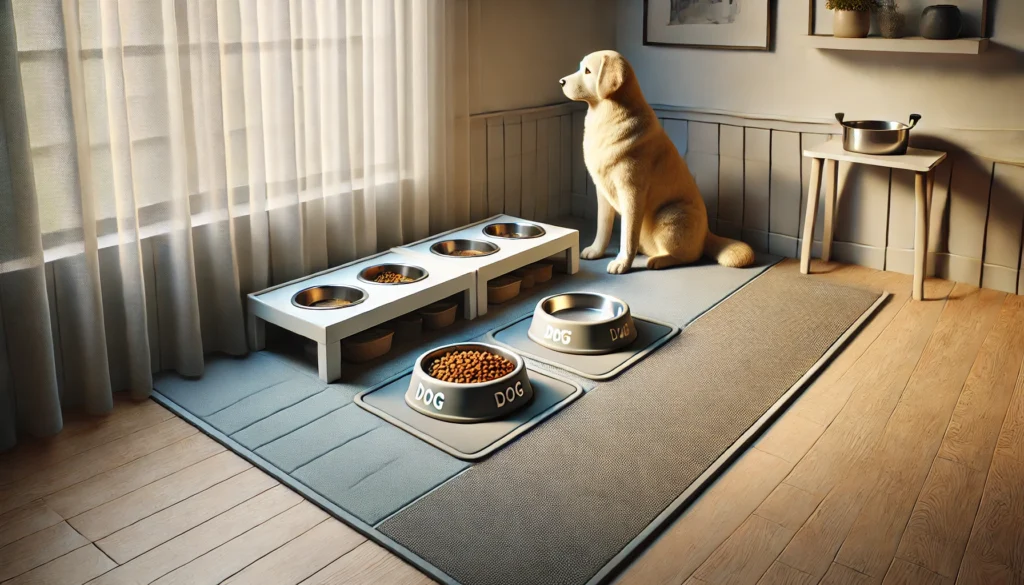Feeding time in a home with multiple pets — whether it’s two dogs, two cats, or a mix — can quickly become chaotic. From food stealing to tension and resource guarding, sharing a space doesn’t always mean sharing meals peacefully.
A thoughtfully designed indoor feeding station creates boundaries, reduces stress, and promotes calm, healthy eating habits for all your pets. Whether you live in a small apartment or a large home, this guide will show you how to create a structured feeding area that works for multi-pet households.
Why Structured Feeding Matters
When pets share space during meals without clear separation, it can lead to:
- Food guarding and defensive behavior
- Speed eating or vomiting
- Stealing food from others
- Anxiety or fear during mealtime
- Overeating or underfeeding in one or more animals
Feeding stations support routine, fairness, and comfort — especially when your pets have different dietary needs, personalities, or meal speeds.
Key Principles of a Good Feeding Station
Whether you’re feeding two dogs, two cats, or both, keep these principles in mind:
- Separation: Physical or visual boundaries between animals
- Predictability: Routine times, spots, and portions
- Cleanliness: Easy-to-clean surfaces and bowls
- Safety: No access to each other’s food
- Comfort: Quiet, distraction-free location
You don’t need a dedicated room — just a planned layout and a few pet-friendly tools.
Choosing the Best Location in Your Home
Select a quiet, low-traffic area with room for each pet to eat comfortably. Ideal spots include:
- A kitchen corner with mats for each pet
- A hallway or laundry area (with wipeable floors)
- Opposite corners of a shared room
- Elevated spots for cats (out of dog’s reach)
- Crate or playpen setups for feeding
Avoid entryways or rooms where humans frequently walk through — pets should feel safe and undisturbed.
Feeding Station Layout Options
Here are popular layouts for different home sizes and pet combinations:
1. Side-by-Side With Distance
- Place bowls 2–3 feet apart
- Use rubber feeding mats to define each pet’s zone
- Ideal for pets who coexist peacefully but need boundaries
2. Crate or Gate Separation
- Feed each pet inside their crate or behind a baby gate
- Prevents food stealing and stress
- Great for pets with special diets or guarding behaviors
3. Vertical Feeding for Cats
- Place cat bowls on a counter, shelf, or cat tree platform
- Keeps dog from accessing cat food
- Adds space efficiency in small homes
4. Room Division
- Feed pets in separate rooms with closed doors
- Especially helpful during training or introduction periods
You can combine methods depending on time of day, food type (kibble vs. wet), or pet personality.
Choosing Bowls and Accessories
Use bowls that are:
- Stainless steel (most hygienic and durable)
- Anti-slip with a rubber base
- Elevated for senior dogs or large breeds
- Slow-feeder style for fast eaters
Also consider:
- Spill-proof water stations
- Automatic feeders with RFID or timed access
- Wall-mounted or tray-based setups for cleanliness
Clean bowls daily and replace plastic ones regularly to avoid bacteria buildup.
Meal Prep Tips for Harmony
1. Stick to a Schedule
- Feed at the same times every day
- Offer meals for a set window (10–15 minutes)
- Remove uneaten food to avoid grazing
2. Supervise Until Finished
- Especially early in training, stay nearby
- Prevent food theft or bowl guarding
- Praise calm behavior and reinforce meal zone usage
3. Use Commands
- Train pets to wait with “sit” or “stay” before eating
- Use release cues like “okay” to begin
- Redirect attention if one finishes early
Feeding Time With Different Diets
If your pets have different needs — one on prescription food or puppy chow — feeding zones become even more essential.
- Label bowls or color-code mats
- Use barriers or crates
- Monitor intake carefully to avoid sharing or contamination
Consider food puzzles for mental enrichment or to slow down overeaters.
Preventing and Managing Resource Guarding
Signs of guarding include stiff body posture, growling, or eating with extreme speed. Reduce this behavior by:
- Separating pets during meals
- Never taking food away without a trade
- Avoiding punishment — focus on prevention
- Feeding in crates or with physical dividers if needed
- Consulting a behaviorist if aggression escalates
Peaceful feeding starts with feeling safe.
Keeping the Station Clean and Odor-Free
- Wipe mats and bowls daily
- Wash water bowls every 2–3 days
- Clean surrounding floors weekly
- Store kibble in airtight containers
- Use washable placemats for easy rotation
A tidy station reduces mess, pests, and discomfort for both pets and people.
Training Positive Feeding Habits
Start young or early in the process:
- Use calm cues for sit, wait, and release
- Don’t hover — give space once training is in place
- Use treats to reinforce post-meal calmness
- Practice short “settle” times after eating to prevent overstimulation
Consistency is key — pets love predictable mealtime structure.
A More Peaceful Feeding Experience
Feeding time doesn’t need to be a daily source of chaos. With the right space, tools, and training, your multi-pet household can enjoy calm, respectful meals — no growling, stealing, or stress.
Your pets deserve to feel safe and secure at their bowls. And you deserve a clean, structured space that supports healthy habits for everyone.






